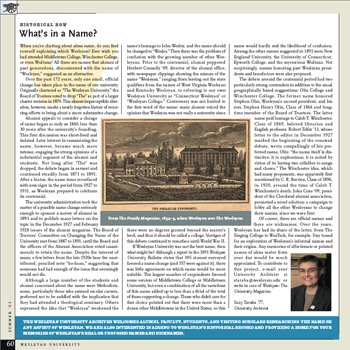HISTORICAL ROW: WHAT’S IN A NAME?
 When you’re chatting about alma mater, do you find yourself explaining which Wesleyan? Ever wish you had attended Middletown College, Winchester College, or even Wultuna? All three are names that alumni of past generations, discontented with the name of “Wesleyan,” suggested as an alternative.
When you’re chatting about alma mater, do you find yourself explaining which Wesleyan? Ever wish you had attended Middletown College, Winchester College, or even Wultuna? All three are names that alumni of past generations, discontented with the name of “Wesleyan,” suggested as an alternative.
Over the past 172 years, only one small, official change has taken place in the name of our university. Originally chartered as “The Wesleyan University,” the Board of Trustees voted to drop “The” as part of a larger charter revision in 1870. This almost imperceptible alteration, however, masks a nearly forgotten history of recurring efforts to bring about a more substantive change.
Alumni appeals to consider a change of name began as early as 1860, less than 30 years after the university’s founding. This first discussion was short-lived and isolated. Later interest in reexamining the name, however, became much more intense, engaging the strong opinions of a substantial segment of the alumni and students. Not long after “The” was dropped, the debate began in earnest and continued steadily from 1871 to 1891. After a hiatus, the name issue resurfaced with new vigor in the period from 1927 to 1931, as Wesleyan prepared to celebrate its centennial.
The university administration took the matter of a possible name change seriously enough to sponsor a survey of alumni in 1891 and to publish many letters on the topic in the December 1927 and February 1928 issues of the alumni magazine. The Board of Trustees’ Committee on Changing the Name of the University met from 1887 to 1891, until the Board and the officers of the Alumni Association voted unanimously to retain the name. Despite the interest of many, a few letters from the late 1920s bear the unattributed, penciled note “ho-hum,” suggesting that someone had had enough of the issue that seemingly would not die.
Although a large number of the students and alumni concerned about the name were Methodists, some, particularly those who entered secular careers, preferred not to be saddled with the implication that they had attended a theological seminary. Others expressed the idea that “Wesleyan” weakened the name’s homage to John Wesley, and the name should be changed to “Wesley.” Then there was the problem of confusion with the growing number of other Wesleyans. Prior to the centennial, alumni peppered Herbert Connelly ’09, director of the alumni office, with newspaper clippings showing the misuse of the name “Wesleyan,” ranging from leaving out the state qualifiers from the names of West Virginia Wesleyan and Kentucky Wesleyan, to referring to our own Wesleyan University as “Connecticut Wesleyan” or “Wesleyan College.” Controversy was not limited to the first word of the name: many alumni voiced the opinion that Wesleyan was not really a university since there were no degrees granted beyond the master’s level, and thus it should be called a college. Vestiges of this debate continued to resurface until World War II.
If Wesleyan University was not the best name, then what might be? Although a report in the 1891 Wesleyan University Bulletin states that 385 alumni surveyed favored a name change (and 357 were against it), there was little agreement on which name would be more suitable. The largest number of respondents favored some version of Middletown College or Middletown University, but even a combination of all the variations of this name added up to less than a third of the total of those supporting a change. Those who didn’t care for that choice pointed out that there were more than a dozen other Middletowns in the United States, so this name would hardly end the likelihood of confusion. Among the other names suggested in 1891 were New England University, the University of Connecticut, Epworth College, and the mysterious Wultuna. Not surprisingly, names honoring past Wesleyan presidents and benefactors were also proposed.
The debate around the centennial period had two particularly strong contenders in addition to the usual geographically based suggestions: Olin College and Winchester College. The former name honored Stephen Olin, Wesleyan’s second president, and his son, Stephen Henry Olin, Class of 1866 and long-time member of the Board of Trustees. The latter name paid homage to Caleb T. Winchester, Class of 1869, beloved librarian and English professor. Robert Telfer ’13, whose letter to the editor in December 1927 marked the beginning of the renewed debate, wrote compellingly of his preferred name, Olin: “the name itself is distinctive; it is euphonious; it is suited by virtue of its having two syllables to songs and cheers.” The Winchester idea, which had many proponents, was apparently first mentioned by C. R. Berrien, Class of 1896, in 1920, around the time of Caleb T. Winchester’s death. John Coxe ’09, president of the Cleveland alumni association, promoted a novel solution: a campaign to lobby all the other Wesleyans to change their names, since we were first.
Of course, there are official names and there are nicknames. Over the years, Wesleyan has had its share of the latter, from The Singing College to WesTech, for example. Stay tuned for an exploration of Wesleyan’s informal names and their origins. Any memories of affectionate or pointed names of alma mater from your day would be much appreciated. To contribute to this project, e-mail your University Archivist at staraba@wesleyan.edu or write in care of Wesleyan: The University Magazine.
— Suzy Taraba ’77,
University Archivist
